The Allan Line and Their Turbine Steamships To Canada
How to get to Canada? Why nothing is more easily done. Book your passage on the Allan Line from Liverpool, Glasgow, or Londonderry, pay your fare, and Allan. Bros. and Co. will do " all the rest."
Pioneer of Canadian Transatlantic Service
The Allan Line has been the pioneer of the Canadian Atlantic Ferry from the very first. The birth, growth, and development of this line are inseparably associated with the history of Canada.
The Allan's were Scotchman, but they had in them the reincarnated soul of Cabot and his three sons, who, more than four hundred years ago, first carried the English flag up the Gulf of St. Lawrence.
It is curious to see how little Englishmen have done to discover and develop Canada. What is now the Canadian Dominion was first discovered in 1497 by a Venetian. The Portuguese followed, but beyond kidnapping some Indians for slaves, they did nothing to develop the country.
Then came some Bretons from Brittany, who left Cape Breton on the map as a souvenir of their visit. After them, a Florentine and a Spaniard, in the service of the French King, annexed the country somewhat under the fashion of De Brazza, with his pocket-handkerchief treaties, and afterward, it was first opened up to European colonization by a Frenchman, Jacques Cartier.
In our days it was an Irishman who crushed the Red River revolt, a native of Glasgow who founded the Mc Gill University. When Canada became a Dominion, both her political leaders, Macdonald and Mackenzie, were Scotchmen.
Lord Strathcona is a Scotchman, and it is but in accordance with the record of the Dominion that the Canadian Ferry should have been front the first to last in the hands of Scotchmen.
Seven years after the battle of Waterloo, Alexander Allan, captain of the brig Fean, sailed from Glasgow for Quebec. No one paid much attention to the voyage.
The brig Fean was, however, in its way worthy of ranking with the caravels of Columbus and of Cabot, with the mythic -Argo - mud and the sacred Mayflower. For that tiny vessel, whose tonnage was not one-fiftieth part of the Victorian, was the progenitor of the Allan Line, one of the most famous of the mercantile fleets of the Empire.
The seed sown in 1822 did not spring up very quickly. In 1830 the Fean had been succeeded by four sailing vessels, which regularly plied between Canada and the British ports. It was not till 1852 that the first attempt was made to establish a Canadian steam ferry.
The Canadian Government entrusted the task to a firm which promised well, but performed so severely, that before a twelvemonth was over they were glad to hand the responsibilities over to Messrs. Allan, who, in 1853, began a fortnightly service between Liverpool and Quebec and Montreal in the summer months, and Liverpool and Portland, Maine, in winter time.
The First Allan Line Mail Steamers
Their first mail steamer which, like all the early steamers, carried sails, was the two-funneled Canadian, of about moo tons burden. In 1858 the fortnightly service was found to be inadequate.
The Allan line in that year started a steamer every week, and have kept it up ever since. The ships have grown bigger and bigger every decade. One of the crack linen today is as large as seven Canadians of fifty years ago, and still, the limit of size is not reached.
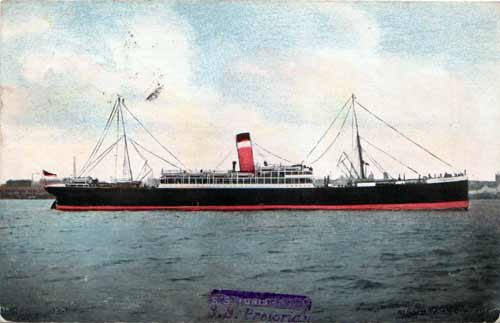
Allan Line TSS Tunisian - 10,567 Tons
It has been the pride of the Allan Line to be pioneers of all the improvements that modern science and modern ingenuity can suggest for increasing the speed or of improving the comfort of the Transatlantic service.
They were not only the pioneers both of the sailing and the steamship ferry between Canada and Britain, but they were also the first to adopt many of the most valuable improvements in the construction of liners.
The New Turbine Driven Twin-Screw Steamships
And now this famous line is about to forge ahead once more. They have beaten all their rivals in utilizing the turbine for ocean liners of the first class.
Their new turbine steamer the Victorian will be on the ferry at the beginning of 1905, and she will be very shortly joined by her sister-ship the Virginian. It is noteworthy that neither of these vessels has been built in England.
The Victorian was built at Belfast. The Virginian on the Clyde. There is little doubt that the turbine is destined to supersede the marine engine.
Admiral Fisher prophesied last year that in five years time the whole British navy would be turbine-driven. The same considerations which have led to its adoption in private yachts will compel its adoption on all passenger steamers.
Sir George Newnes's new yacht, now being built on the Tyne, will be driven by turbines, not so much for speed as because the adoption of the turbine liberates so much space that every passenger can have a four-post bed in his cabin, and the passages are broad enough for three men to walk abreast. The new Cunarders will be fitted with turbines.
But while the turbine Cunarders are building, the Allan Line turbine steamer is in the water. Increased speed, diminution of attendance, the economy of space, absence of vibration, a reduction of weight, utilization of the last ounce of steam power, and less danger of breakdown—these are the advantages which are enabling the turbine to kill out the reciprocating engine.
The Allan Line SS Victorian
The Victorian is a vessel of 12,000 tons register. Its capacious hold will carry 8,000 tons deadweight of cargo, besides 1,300 passengers. It will be driven at the rate of from eighteen to twenty knots an hour by three propellers, which will be rotated at from 270 to 300 revolutions per minute by one high-pressure and two low-pressure Parson's turbines.
The side screws are worked by the low-pressure turbines and have a reversing arrangement which enables them to be driven full speed astern either together or independently. By this means the Victorian and Virginian will be as much under command for backing or turning as any ordinary steamship.
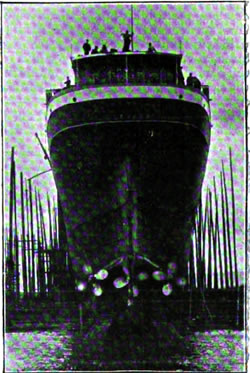
View of the Stern showing the Triple Scews of the Allan Line TSS Victorian
It is almost impossible to explain the mystery of the turbine to the ordinary reader. The main idea of it is that the steam instead of driving a piston backward and forwards and rotating the shaft of the propeller is passed directly into a cylinder, within which there turns a massive drum weighing ninety-five tons, built on the shaft of the propeller.
Between the drum and the cylinder, down a devious path obstructed by flanges or rings of brass blades, the steam rushes impetuous from the boilers, and as it can only get out by thrusting the drum round, the screw is by this means made to rotate.
The marvel and the mystery—we might also say the miracle —consist in the number and exactitude of the brass blades which guide the steam. They are tiny, fragile-looking points, not more substantial than a lady's little finger. But there are no less than one million and a-half used in the three turbines in the Victorian.
There are no moving parts to break or to get out of order, and everything depends upon the proper " set " and inclination of the two sets of blades. The energy of the steam is used up to the last ounce in its passage through the turbine.
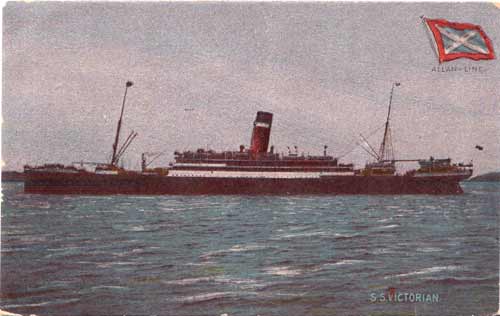
urbine Driven TSS Victorian and Virginian - both 12,000 Tons
The Allan liners the Tunisian and the Bavarian have long been famous for their comfort, convenience, security, and stability. It is expected that the Victorian and the Virginian will be all that these crack boats have been, only more so.
On these steamers, instead of utilizing the space economized by the turbines to carry more passengers, it has been used to increase the comfort and luxury of the accommodation.
The length of the Victorian is 540 feet; her breadth 6o feet; her depth 40 feet 6 inches. She is divided by bulkheads into eleven compartments, and with the subdivisions of her double-bottom, she has twenty watertight spaces.
She is built to the highest class of the British Corporation Registry of Shipping, and her hull has been specially strengthened above the requirements of the Corporation to make her doubly secure against the heavy weather of the North Atlantic.
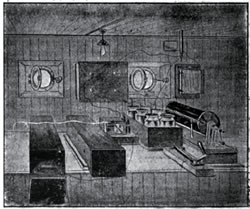
Marconi Wireless onboard an Allan Line Steamship
The first-class accommodation, which, as usual, is amidships, is of the most complete and approved order. Perfectly heated and ventilated staterooms and suites of rooms, a spacious and well-fitted dining-saloon, an elegantly appointed music-room, and a luxuriously equipped smoke room are some of the features.
Not less comfortable proportionately are the second-class quarters, and, as already indicated, third-class passengers are catered for most liberally.
Electric light throughout, a complete printing outfit, and installation of Marconi's wireless telegraphy are among the arrangements for the comfort and convenience of passengers.
Allan Line One of the Most Popular Atlantic Lines
The enterprise and the caution of the Allan Line, and the comfort of their boats combine to make their Canadian Ferry one of the most popular of the Atlantic lines. But they have got an immense advantage over all their competitors in the fact that they command the shortest sea route.
From Liverpool to Londonderry the liners are almost in land-locked waters. And they are again within the solid grasp of the shore when they reach Belle Isle Strait.
They thus cut the open ocean voyage down to 1,650 miles, and this they cover in four days and a half. The first European keels that plowed the waters of the St. Lawrence were those of the caravels of John Cabot, who was sent out by the citizens of Bristol to discover the North-West passage to far-away Cathay.
A whole continent barred the path of the adventurous navigator. But that continent has now been bridged by the iron road, and the swiftest route to the fair East now lies along the track of the early navigator.
When Jules Verne's traveler tries to cut the record for a round-the-world journey, he will, when peace is restored in Manchuria, always take Canada en route.
This is the shorter route. The scenery en route is much more interesting than that on the American lines, as the Scottish landscape is more romantic than English.
Connections between England and Canada
Whether the voyager disembarks at Quebec, Montreal, or Halifax, Messrs. Allan's steamers connect in each case with the systems of the Canadian Pacific and the Grand Trunk Railways, so that the passenger can, before he sets foot on ship-board, be booked through to any point in British North America or the United States.
At the ports named, the steamship piers are adjacent to the railway stations, so that the passenger and his effects are entrained without delay, and, what is equally important, without the slightest extra expense.
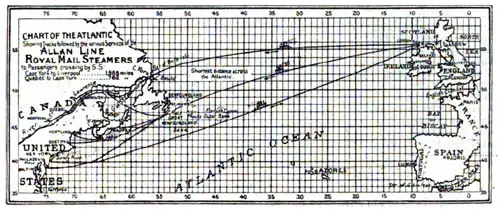
Chart of the Atlantic showing the routes used by the Allan Line between England and Canadian Ports.
The traveler from London is taken directly to the landing-stage at which the steamer is lying. The Liverpool sailing day is Thursday and the time 3.30 p.m. in the winter, and 4.30 p.m. during the summer months.
Thus the London passenger can leave the Metropolis at noon, lunch en route in the train, and have dinner in the Irish Sea, so nicely dove-tailed are the sailing arrangements.
It's The Little Things That Count Too
As to the table kept on the Allan steamships, the traveling public has long appreciated its excellence and variety, the menu is equal to that of a first-class hotel, and the service of the very best.
Breakfast is served from 8.30 to 10 a.m., luncheon at 1.30 p.m., and dinner at 7 p.m., and such little make-shifts as afternoon tea and supper as passengers desire them.
Afternoon tea is quite a function on hoard an Allan Liner, the ladies holding their levies and expecting the attendance of the gentlemen just as if they were in their own drawing-rooms.
The Allan Line is one of the strongest links in the chain that unites the Dominion with the Realm. It has converted that which divided and estranged, by a spacious, pleasurable, and health-giving moving ferry, into an element which unites.
For as Wordsworth so finely sang at the beginning of the century, when the silent highway of our ocean Venice was as yet unploughed by the propeller, as the bees swarm through the air.
Source: The Review of Reviews, Volume 30, December 1904, The Allan Line, and Their Turbine Ferry To Canada, Pages 683 - 686. Editied for grammar and spelling by P. K. Gjenvick, 2019.
